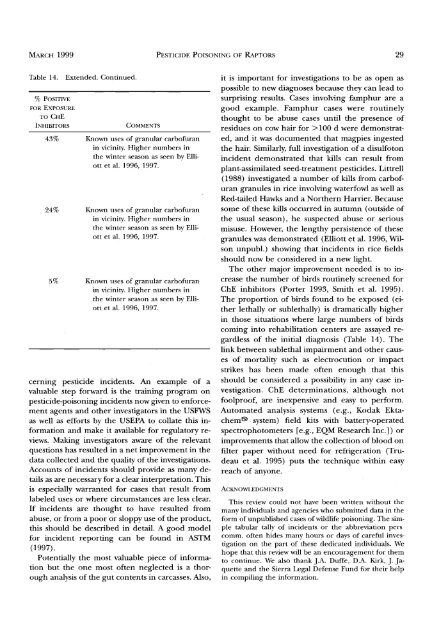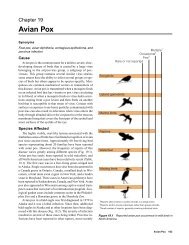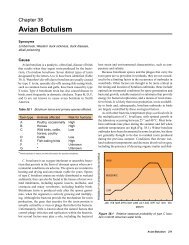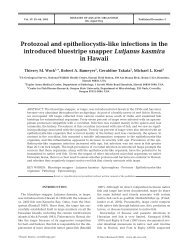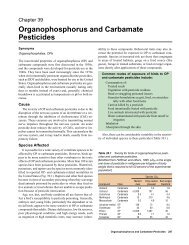poisoning of raptors with organophosphorus and carbamate ...
poisoning of raptors with organophosphorus and carbamate ...
poisoning of raptors with organophosphorus and carbamate ...
Create successful ePaper yourself
Turn your PDF publications into a flip-book with our unique Google optimized e-Paper software.
M_A•CH 1999 PESTICIDE POISONING OF RAPTORS 29<br />
Table 14. Extended. Continued.<br />
% POSITIVE<br />
FOR EXPOSURE<br />
TO CHE<br />
INHIBITORS<br />
COMMENTS<br />
43% Known uses <strong>of</strong> granular carb<strong>of</strong>uran<br />
in vicinity. Higher nuInbers in<br />
the winter season as seen by Elliott<br />
et al. 1996, 1997.<br />
24% Known uses <strong>of</strong> granular carb<strong>of</strong>uran<br />
in vicinity. Higher numbers in<br />
the winter season as seen by Elliott<br />
et al. 1996, 1997.<br />
5% Known uses <strong>of</strong> granular carb<strong>of</strong>uran<br />
in vicinity. Higher numbers in<br />
the winter season as seen by Elliott<br />
et al. 1996, 1997.<br />
cerning pesticide incidents. An example <strong>of</strong> a<br />
valuable step forward is the training program on<br />
pesticide-<strong>poisoning</strong> incidents now given to enforcement<br />
agents <strong>and</strong> other investigators in the USFWS<br />
as well as efforts by the USEPA to collate this information<br />
<strong>and</strong> make it available for regulatory reviews.<br />
Making investigators aware <strong>of</strong> the relevant<br />
questions has resulted in a net improvement in the<br />
data collected <strong>and</strong> the quality <strong>of</strong> the investigations.<br />
Accounts <strong>of</strong> incidents should provide as many de-<br />
tails as are necessary for a clear interpretation. This<br />
is especially warranted for cases that result from<br />
labeled uses or where circumstances are less clear.<br />
If incidents are thought to have resulted from<br />
abuse, or from a poor or sloppy use <strong>of</strong> the product,<br />
this should be described in detail. A good model<br />
for incident reporting can be found in ASTM<br />
(1997).<br />
Potentially the most valuable piece <strong>of</strong> information<br />
but the one most <strong>of</strong>ten neglected is a thorough<br />
analysis <strong>of</strong> the gut contents in carcasses. Also,<br />
it is important for investigations to be as open as<br />
possible to new diagnoses because they can lead to<br />
surprising results. Cases involving famphur are a<br />
good example. Famphur cases were routinely<br />
thought to be abuse cases until the presence <strong>of</strong><br />
residues on cow hair for >100 d were demonstrat-<br />
ed, <strong>and</strong> it was documented that magpies ingested<br />
the hair. Similarly, full investigation <strong>of</strong> a disulfoton<br />
incident demonstrated that kills can result from<br />
plant-assimilated seed-treatment pesticides. Littrell<br />
(1988) investigated a number <strong>of</strong> kills from carb<strong>of</strong>uran<br />
granules in rice involving waterfowl as well as<br />
Red-tailed Hawks <strong>and</strong> a Northern Harrier. Because<br />
some <strong>of</strong> these kills occurred in autumn (outside <strong>of</strong><br />
the usual season), he suspected abuse or serious<br />
misuse. However, the lengthy persistence <strong>of</strong> these<br />
granules was demonstrated (Elliott et al. 1996, Wilson<br />
unpubl.) showing that incidents in rice fields<br />
should now be considered in a new light.<br />
The other major improvement needed is to increase<br />
the number <strong>of</strong> birds routinely screened for<br />
ChE inhibitors (Porter 1993, Smith et al. 1995).<br />
The proportion <strong>of</strong> birds found to be exposed (either<br />
lethally or sublethally) is dramatically higher<br />
in those situations where large numbers <strong>of</strong> birds<br />
coming into rehabilitation centers are assayed re-<br />
gardless <strong>of</strong> the initial diagnosis (Table 14). The<br />
link between sublethal impairment <strong>and</strong> other causes<br />
<strong>of</strong> mortality such as electrocution or impact<br />
strikes has been made <strong>of</strong>ten enough that this<br />
should be considered a possibility in any case investigation.<br />
ChE determinations, although not<br />
foolpro<strong>of</strong>, are inexpensive <strong>and</strong> easy to perform.<br />
Automated analysis systems (e.g., Kodak Ekta-<br />
chem • system) field kits <strong>with</strong> battery-operated<br />
spectrophotometers [e.g., EQM Research Inc. I) or<br />
improvements that allow the collection <strong>of</strong> blood on<br />
filter paper <strong>with</strong>out need for refrigeration (Trudeau<br />
et al. 1995) puts the technique <strong>with</strong>in easy<br />
reach <strong>of</strong> anyone.<br />
ACKNOWLEDGMENTS<br />
This review could not have been written <strong>with</strong>out the<br />
many individuals <strong>and</strong> agencies who submitted data in the<br />
form <strong>of</strong> unpublished cases <strong>of</strong> wildlife <strong>poisoning</strong>. The simple<br />
tabular tally <strong>of</strong> incidents or the abbreviation pers<br />
comm. <strong>of</strong>ten hides many hours or days <strong>of</strong> careful investigation<br />
on the part <strong>of</strong> these dedicated individuals. We<br />
hope that this review will be an encouragement for them<br />
to continue. We also thank J.A. Duffe, D.A. Kirk, J. Jaquette<br />
<strong>and</strong> the Sierra Legal Defense Fund for their help<br />
in compiling the information.


